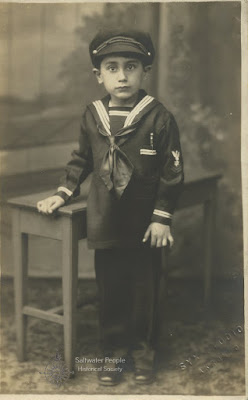Steel Mosquito
"Rate wars and rivalries represented only the exciting and colorful sidelights of the development of inland water transportation in the Puget Sound region as it approached its glory days and subsequent swift decline. More significant events in the affairs of Joshua Green and Charles Peabody [Puget Sound Navigation Co] transpired during the first decade of the 20-C, although with less publicity.(Joshua Green, in his words, was the largest individual stockholder of the company from the time of its formation in 1901 until he sold his stock to Capt. Alex Peabody and associates in 1927.)
In 1908 the PSNC had taken over Colman Dock at the foot of Marion Street. This pier, its ornate Victorian clock tower and domed waiting room roof providing a Seattle waterfront landmark, remained headquarters of the company's steamers throughout the rest of the steamboat era, and through the decadent days of the automobile ferries which replaced them.
 |
H.B. KENNEDY 206030 Litho postcard from the archives of the S.P.H.S.© |
The first brand-new steel steamer was placed under company operation when the 179-ft H.B. KENNEDY was completed at Portland for the joint Kennedy-Puget Sound Navy Yard Route. The handsome two-stacker came up the coast under her own power, commanded by Capt. W.E. (Billy) Mitchell, in command for her first 8 years of operation, a total of 408,000 miles. She knifed her way up the Sound from Port Angeles to Seattle at better than her specified speed of 22-mph. That afternoon, with a party of company officials on board, the KENNEDY continued to show off, chasing the INDIANAPOLIS that was minding her business on the regular Seattle-Tacoma run, and passing her up amid much derisive whistling. Capt Penfield, who was still being humiliated by the FLYER, didn't much appreciate the gratuitous insult from a fleet-mate and Joshua Green didn't quite approve of the performance either. H.B. Kennedy, a more flamboyant type, was enjoying the proceedings so thoroughly, however, that he didn't have the heart to expostulate––and he was impressed with the KENNEDY's speed, and by the fact that, at normal cruising rates, her modern engines consumed little more fuel than some of the smaller and slower steamers of the fleet.
The KENNEDY wound up the day's festivities by lying in wait in Elliott Bay for the FLYER to come in from Tacoma. She then pranced out, all flags flying, to challenge that notable old champion. Captain Coffin was already slowing down for his landing, the FLYER was blowing off steam, and he disdainfully ignored the gaudy newcomer.
Like the giant Diesel-electric 'super ferries' that have taken over her old run to Bremerton, the H.B. KENNEDY suffered a number of minor mechanical difficulties during her shakedown period, but when these were solved, she continued to perform her duties efficiently and just as rapidly as the maritime marvels of sixty years later.
Early in her career, the KENNEDY was diverted to the Moran Shipyard for tests and inspection, for Joshua Green was dickering with that firm on the possible construction of more modern steel steamers. She was raced over the measured mile course at a speed of over 21-mph, with Green, Manager Frank Burns and J.W. Paterson, manager for the firm which had taken over the Moran yard, checking her performance carefully.
Paterson convinced Green that the Puget Sound yard (soon to be named Seattle Construction & Drydock Co) could build steamers just as good as the KENNEDY and could meet or beat Portland's prices. Always a great booster for his adopted home town, Green placed orders with Paterson. The result over the next three years, was a new fleet of handsome and efficient, if not gaudy, home-built Sound packets that were to carry the PSNC house flag throughout the remainder of the Steamboat era.
 |
FERRY SEATTLE (ex-H.B. KENNEDY) Photo is date stamped 5 May 1924; The Navy Yard Route's new ferry. She was scrapped in 1938. Photographer unknown. Original photo from the archives of the S.P.H.S.© |
In 1924, the H.B. KENNEDY became the steam ferry SEATTLE with the conversion being done at Todd Shipyard."
The [Joshua] Green Years. Newell, Gordon. Superior Publishing Co. 1969
"In 1938 the newly acquired Diesel ferries came up from San Francisco, the KEHLOKEN (ex-GOLDEN STATE), entered service replacing the steam ferry SEATTLE (ex-H.B. KENNEDY), the latter vessel being laid up. Although the replacement of the old steamer of 1909, vintage by the modern Diesel-electric craft, was generally viewed as an example of maritime progress, a few malcontents persisted in pointing out that, whereas the handsome old SEATTLE had operated quite smoothly at a speed of 17.4 mph, the new KEHLOKEN, a remarkably ugly craft, progressed with considerable vibration at a rate of 14 mph." The H.W.McCurdy Marine History of the PNW. Newell, Gordon. Superior Publishing.


















